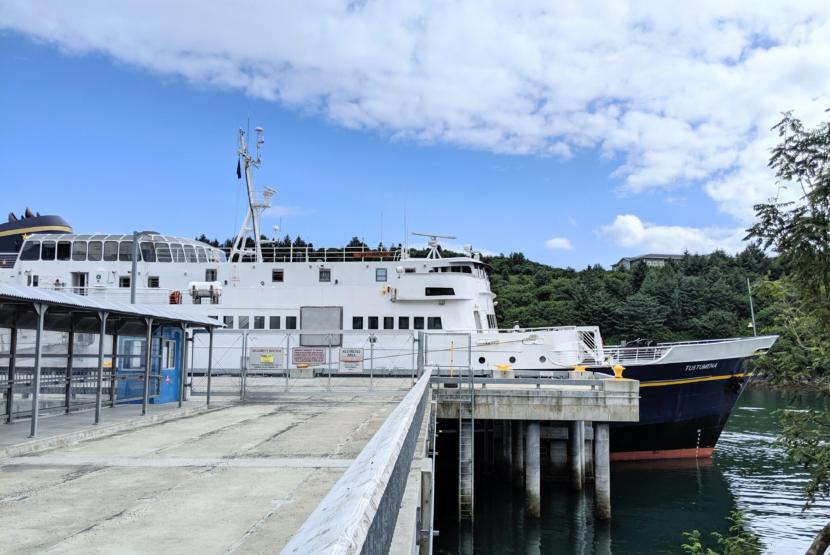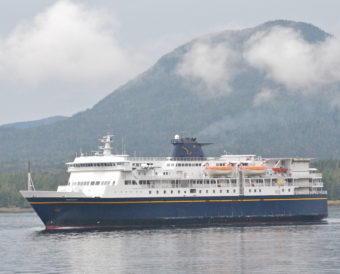
Like many parts of coastal Alaska, Kodiak Island is gearing up for a gap in ferry service this winter. While the city of Kodiak has relatively reliable alternatives for transportation to the mainland, the gap will pose serious difficulties for the some of the island’s outlying villages.
The six coastal villages of Kodiak are remote under any circumstances. All require a bush plane or a boat to reach, and only three receive ferry service at some point in the year. A winter gap in ferry service is standard practice.
But this year’s gap is significantly longer.
Ouzinkie and Port Lions, on the northeast end of the archipelago, will be cut off for three months between January and April. Old Harbor’s last ferry of the year was last week.
Ferries are a cost-effective way for village residents to do the everyday things you’d use a vehicle to do in a larger city: picking up groceries, getting a car to the mechanic, moving building supplies. Residents often schedule their lives around ferry service.
Ouzinkie Vice Mayor Katherine Panamarioff said kids in her village rely on ferries to travel to school sports competitions, and many elders need them to get to doctors’ appointments in town.
“I just had to take my mother in a ferry on Monday. She would not fly,” Panamarioff said. “There are some people that will not fly, and so that’s their only way of getting to and from either Kodiak or Homer.”
The alternatives — chartering a boat or a plane — are significantly more expensive. And particularly in winter, Panamarioff said ferries are just more reliable.
“A lot of times, you can’t even get in and out of the community because the weather is so bad,” she said. “The wind is really bad, and the flights cancel. And it’s like that weeks at a time.”
Last month, the Alaska Legislature and Gov. Mike Dunleavy cut $43 million out of the Alaska Marine Highway System budget — a 31% cut from previous years, according to the Alaska Department of Transportation and Public Facilities. As a result, AMHS has had to significantly constrain its sailing schedule.
But another reason for the gap in service is that both the Tustumena and the Kennicott — the ferries that typically serve the island — are scheduled to be in overhaul at the same time this year.
According to Transportation spokesperson Meadow Bailey, that happens every year, but this year “there’s a longer period of time, because there’s more overhaul that needs to be done, like more work that needs to be completed in that time frame.”
The Kennicott, the larger of the two ferries, goes offline in early October. And that means that the whole island will be relying on the smaller Tustumena, until it too stops running in January.

Port Lions Mayor Dorinda Kewan worries that without the Kennicott handling the heavy traffic from the city of Kodiak to the mainland, village residents will have to compete for space to book vehicles on the Tustumena.
“So the traffic that would normally have been going between Homer and Kodiak on the Kennicott is going to book itself on the Tustumena, so we are going to have to plan way in advance if we want to get a space on the Tustumena between Port Lions and Kodiak,” Kewan said.
Adding in the new sliding fare and cancellation fee schedule, Kewan predicts planning routine tasks over the next few months is going to be a logistical headache for passengers in Port Lions or Ouzinkie.
“If we want to do any doctor appointments or dental appointments, we’re gonna need to get those booked,” Kewan said. “So we literally need to know what we’re doing. If we’re going to use the ferry service between now and January, we need to know that by Oct. 1. And we need to book those tickets.”
To some extent, the cuts to service just make ferry travel for village residents more difficult, planning-wise. But Kewan said the longer gap this winter might mean that people end up paying more to fly, with more limited space and no vehicles.
It’s possible, she said, they’ll just have to make do without as many trips to town.
